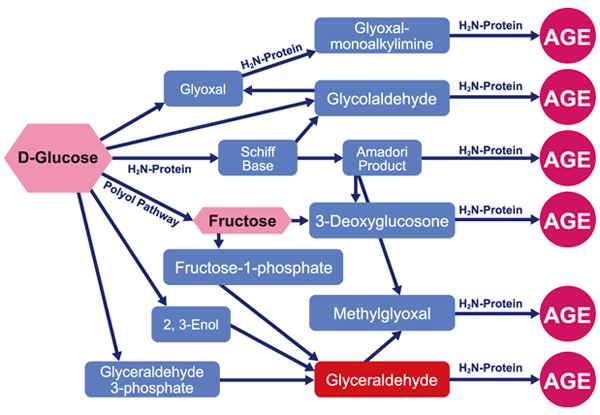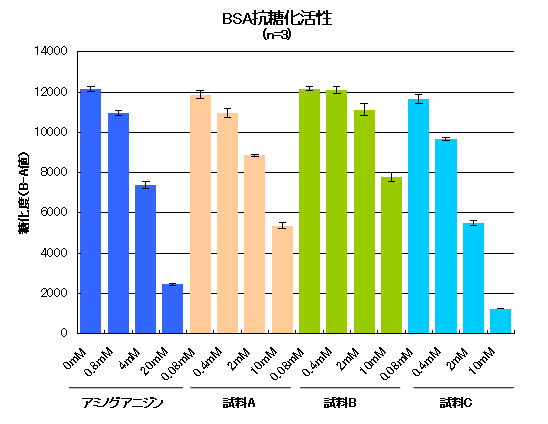Albumin Anti-Glycation Assay Kit (Glyceraldehyde)
For anti-aging research
The albumin anti-glycation assay kit (glyceraldehyde) is a kit that allows you to follow the glycation reaction of albumin in a cell-free and non-enzymatic manner using a 96-well plate. By using glyceraldehyde, a sugar metabolism intermediate, it is possible to screen substances that inhibit the glycation reaction of albumin in a shorter period of time. Please use it for the development of anti-glycation materials in the development of functional foods and cosmetics.
Background
Saccharides are essential nutrients for life activities, but on the other hand, modification of lysine and arginine residues of proteins in vivo to form cross-links changes the three-dimensional structure of proteins, which can greatly affect their activity and physical properties. is known. This reaction is called the glycation reaction (Glycation) or the Maillard reaction, and through the early reaction in which Amadori rearrangement products are formed, and reactions such as oxidation, dehydration, and condensation, advanced glycation end-products (AGEs) are formed. can be divided into late reactions.
In recent years, it has been reported that AGEs are produced in vivo not only from glucose, but also from metabolic intermediates, degradation products, and Maillard reaction intermediates of glucose. It has been reported that AGEs derived from glyceraldehyde derived from are strongly involved in the onset and progression of diseases.

figure. Generation pathway of AGEs in vivo
Composition
| Kit contents | capacity | Number | storage temperature |
| Bovine serum albumin (BSA) solution | 10 mL | One | 4°C |
| Glyceraldehyde solution (500 mM) | 2 mL | One | |
| buffer | 30 mL | One | |
| Aminoguanidine solution (20 mM) | 0.5mL | One | |
| *Anti-glycation standard substance |
Example Investigation of saccharified BSA production by saccharification with glyceraldehyde solution
Anti-glycation activity of aminoguanidine and samples A, B, and C of BSA was examined. It was confirmed that each sample had concentration-dependent anti-glycation activity. However, the concentration indicates the concentration in the sample solution.

References
- Rungaroon Waditee-Sirisattha, Hakuto Kageyama.
Protective effects of mycosporine-like amino acid-containing emulsions on UV-treated mouse ear tissue from the viewpoints of antioxidation and antiglycation, Journal of Photochemistry & Photobiology, B: Biology , 223 (2021) 112296
| Catalog Number | Product Name | Size |
| CSR-AAS-AGE-K01 | Albumin Anti-Glycation Assay Kit (Glyceraldehyde) | 1 Kit [96 well x 2] |
